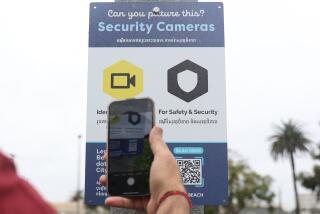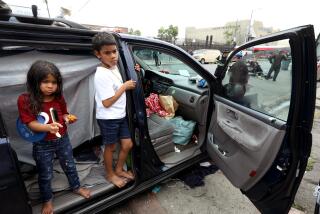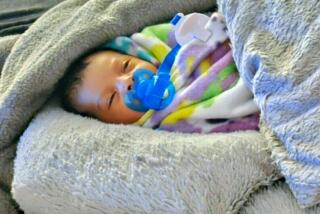Videos, Fingerprints Recorded to Help Trace Abducted Children
SANTA ANA — Despite his whimpers and demands to be taken home, 3-year-old Ryan Segovia was fingerprinted and videotaped Saturday for his own good.
His mother, Sylvia Segovia, said she had wanted to make records of Ryan to help authorities find him if he is ever missing. KinderVision, a nonprofit, educational safety program for children, provided the service through corporate sponsors.
From noon until 3 p.m., about 200 children and their families lined up at Kragen Auto Works on Bristol Street here to get free information on how to prevent kidnapings and to receive tools to help authorities in case an abduction occurs.
Each family received a videotape showing the child talking to the camera and an information card with the youngster’s vital statistics, physical characteristics, medical history, dental chart and fingerprints.
Families also took home educational videotapes, available in English and Spanish, showing them how to help prevent such a tragedy.
“I’m always afraid that someone” could abduct Ryan, said Segovia, 40, of Santa Ana. “If you don’t have records of him, how are they going to find him?”
Since KinderVision was created in June, it has made records for about 8,000 children, said co-founder Douglas Sebastian of San Diego.
The program was inspired by concern over a kidnaping victim. Leticia Hernandez, an Oceanside 7-year-old, was kidnaped early last year. In March, investigators found partial remains of her body near a rural road 22 miles from her home. Her killer has not been found.
Her death was heartbreaking for hundreds of volunteers working to find her, KinderVision organizers said.
“It’s very difficult to find kids once they are gone,” said Sebastian, who was involved with the group San Diegans for the Return of Leticia Hernandez. “So we wanted to try to find educational information on how to prevent kidnaping and put that in the hands of parents and children.”
The educational videotapes feature a police officer and children acting out lessons that both parents and children should remember. The reminders included:
* Families should have safety zones, such as friends’ homes, where a youngster can seek help between home and school.
* Children should be taught tricks that kidnapers might use to lure victims to go with them, such as posing as teachers.
* Children should create a commotion to attract attention if strangers grab them.
* If a strange car pulls alongside, a child should scream for help and turn around to run the other way, because making the driver turn the car around will give the child more time to be rescued.
* Children should not be left unattended in cars.
* A child should always play or walk with other children, not alone.
* Parents should know their children’s playmates, their addresses and their phone numbers.
* Youngsters should be taught how to call 911 and how to call home collect.
The videotape should be shown regularly in homes, KinderVision organizers said.
Parents interviewed said they were mostly recently scared of child kidnaping after they heard about Nadia Puente’s fate.
The fourth-grader was returning home from Diamond Elementary School in Santa Ana on March 20, 1989, when she entered the car of a man claiming to be a teacher. The abductor, Richard DeHoyos, took her to a motel, where he drowned her in the bathtub and sexually assaulted her. Her body was found early next morning wrapped in a blanket in a trash can in Los Angeles’ Griffith Park.
On Oct. 16, a Superior Court jury decided that DeHoyos, an unemployed fast-food worker from Texas, should die in the gas chamber.
“You don’t even think of anything like that happening close by to you,” Segovia said. “You think of it in L.A. but not here in Orange County.”
KinderVision will be available at 11:15 a.m. Saturday in Laguna Niguel at Allen Oldsmobile. On Nov. 23, it will again be offered in Santa Ana at Sanwa Bank at 10 a.m.
More to Read
Sign up for Essential California
The most important California stories and recommendations in your inbox every morning.
You may occasionally receive promotional content from the Los Angeles Times.









